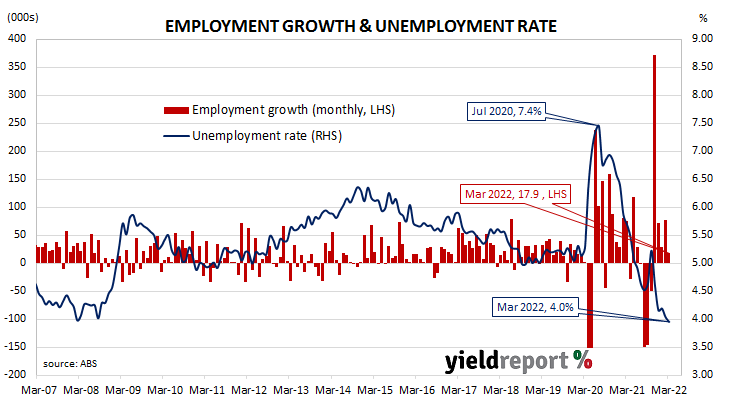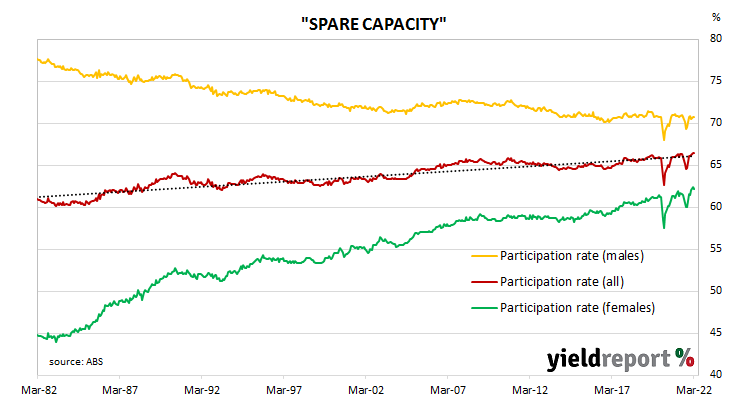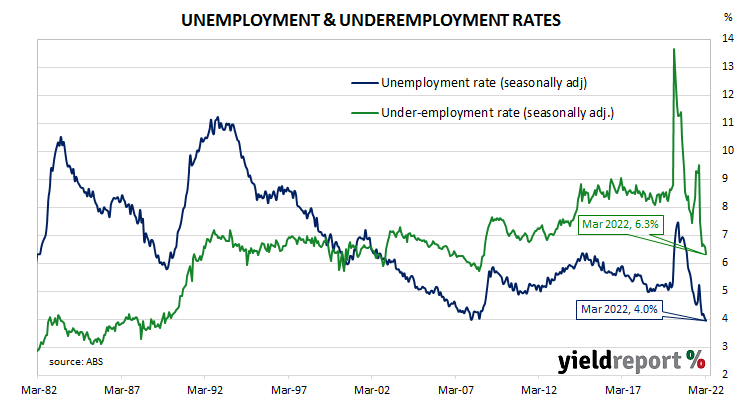Summary: Employment up 17,900 in March, less than expected; headline figure disappoints but details “show continued strength”; participation rate steady at 66.4%; jobless rate remains at 4.0% despite fewer jobseekers, larger workforce; fewer part-time, more full-time jobs; aggregate work hours down 0.6%; underemployment rate down from 6.6% to 6.3%; tightening labour market to put upward pressure on wages growth.
Australia’s period of falling unemployment came to an end in early 2019 when the jobless rate hit a low of 4.9%. It then averaged around 5.2% through to March 2020, bouncing around in a range from 5.1% to 5.3%. Leading indicators such as ANZ’s Job Ads survey and NAB’s capacity utilisation estimate suggested the unemployment rate would rise in the June 2020 quarter and it did so, sharply. The jobless rate peaked in July 2020 but fell below 7% a month later. It has since trended lower.
The latest Labour force figures have now been released and they indicate the number of people employed in Australia according to ABS definitions increased by 17,900 in March. The rise was less than the 30,000 increase which had been generally expected as well as February’s 77,400 increase.
“Headline labour market figures disappointed but the details show continued strength and confirmed last month’s sharp fall in the unemployment rate to its equal lowest since 1974 was very real,” said NAB economist Taylor Nugent.
Domestic Treasury bond yields fell substantially on the day. By the close of business, the 3-year ACGB yield had dropped by 14bps to 2.55%, the 10-year yield had shed 11bps to 3.02% while the 20-year yield finished 8bps lower at 3.36%.
In the cash futures market, expectations of any material change in the actual cash rate, currently at 0.06%, hardened slightly in favour of rate rises in the second half of 2022 but eased for 2023 contracts. At the end of the day, contract prices implied the cash rate would not exceed the RBA’s 0.10% target rate until May and then rise to 0.91% by August. February 2023 contracts implied a cash rate of 2.145%.
The participation rate remained unchanged from February’s 66.4%, as the total available workforce increased by 5,900 to 13.941 million. The number of unemployed persons decreased by 12,000 to 551,300; the slightly lower jobless number and a slightly larger number of people in the workforce resulted in the unemployment rate remaining unchanged at 4.0%.
The aggregate number of work hours across the whole Australian economy declined even as 2,700 residents lost part-time positions and 20,600 residents gained full-time positions. In percentage terms, the total number of work hours fell by 0.6% after jumping by 8.6% in February. On a 12-month basis and after revisions, aggregate hours worked increased by 2.8% as 64,500 fewer people held part-time positions and 402,800 more people held full-time positions than in March 2021.
In recent years, more attention has been paid to the underemployment rate, which is the number of people in work but who wish to work more hours than they do currently. March’s underemployment rate fell from 6.6% to 6.3%.
“Underemployment decreased 0.2ppt to 6.3%, bringing underutilisation to 10.3%. The tightening labour market will continue to put upward pressure on wages growth, which we expect to accelerate this year and next,” said ANZ senior economist Catherine Birch.
The underutilisation rate, that is the sum of the underemployment rate and the unemployment rate, has a strong correlation with the annual growth rate of the ABS private sector wage index when advanced by one quarter. March’s underutilisation rate of 10.3% corresponds with an annual growth rate of about 4.3%.




